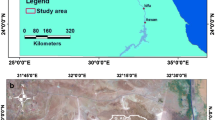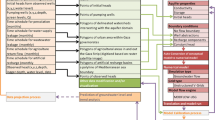Abstract
An integrated GIS-based approach for establishing a spatial and temporal prediction system for groundwater flow and land subsidence is proposed and applied to a subsidence-progressed Japanese coastal plain. Various kinds of fundamental data relating to groundwater flow and land subsidence are digitized and entered into a GIS database. A surface water hydrological cycle simulation is performed using a GIS spatial data operation for the entire plain, and the spatial and temporal groundwater infiltration quantity is hereby obtained. Through the data transformation from the GIS database to a groundwater flow code (MODFLOW), a 3D groundwater flow model is established and unsteady groundwater flow simulation for the past 21 years is conducted with results which compare satisfactorily with observed results. Finally, a Visual Basic code is developed for land subsidence calculations considering aquifer and aquitard deformation. Future land subsidence in the plain is predicted assuming different water pumping scenarios, and the results provide important information for land subsidence mitigation decision-making.





















Similar content being viewed by others
References
Balestri M, Villani B (1991) Study of the subsidence in the Bolognese area. In: Land Subsidence, International Association of Hydrological Sciences, Publication No 200, pp 71–80
Baligh MM (1979) Consolidation theory for cyclic loading. J Geotech Geoenviron Eng, American Society of Civil Engineering(ASCE) 104:127–28
Borsetto M (1984) A 3-D numerical model for subsidence of horizontally layered formation. In: Land Subsidence, International Association of Hydrological Sciences, Publication No 151, pp 65–77
Bravo R (1991) A new three dimensional finite difference model of groundwater flow and land subsidence in the Houston area. In: Land Subsidence, International Association of Hydrological Sciences, Publication No 200, pp 15–26
Corapcioglu MY (1984) One-dimensional land subsidence with variable total stress. In: Land Subsidence, International Association of Hydrological Sciences, Publication No 151, pp 19–28
Dassargues A, Li XL (1991) Computing the land subsidence of Shanghai by a finite element method. In Land Subsidence, International Association of Hydrological Sciences, Publication No 200, pp 613–624
Dassargues A (1995) On the necessity to consider varying parameters in land subsidence computations. In: Land Subsidence, International Association of Hydrological Sciences, Publication No 200, pp 259–68
Daito K, Mizuno M, Ueshita K (1991) Control of groundwater withdrawal for preventing land subsidence in the Owari plain, Japan. In: Land Subsidence, International Association of Hydrological Sciences, Publication No 200, pp 533–544
Esaki T, Zhou GY, Shikata K (1995) Analytical system assisting underground development with prediction and confinement of changes in the subterranean environment. In: Land Subsidence, International Association of Hydrological Sciences, Publication No 234, pp 287–294
Esaki T, Zhou GY et al. (1996) A synthetical system for predicting and measuring groundwater flow and land subsidence in the Saga plain, Japan. Proceedings of the 2nd International Congress on Environmental Geotechnics, Osaka, vol 2, pp 211–216
Esaki T, Aoki K, Kimura T(1991) Surface subsidence in natural gas field. In: Land Subsidence, International Association of Hydrological Sciences, Publication No 200, pp 109–18
Environmental Bureau of Japan(1982) Investigation report of land subsidence mitigation in the Saga plain. Government Open Report
Gambolati G, Ricceri G, Bertoni W (1984) Land subsidence due to gas-oil removal in layered anisotropic soil by a finite element model. In: Land Subsidence, International Association of Hydrological Sciences, Publication No 151, pp 29–41
Gambolati G, Ricceri G, Bertoni W, Brighenti G, Vuillermin E (1991) Numerical analysis of land subsidence at Ravenna due to water withdrawal and gas removal. In: Land Subsidence, International Association of Hydrological Sciences, Publication No 200, pp 119–128
Helm DC (1975) One-dimensional simulation of aquifer system compaction near Pixley, California, (1) constant parameters. Water Resour 11:198–112
Helm DC (1976) One-dimensional simulation of aquifer system compaction near Pixley, California, (2) stress-dependent parameters. Water Resour 12:121–30
Helm DC (1984) Field-based computational technique for predicting subsidence due to fluid withdrawal. Rev Eng Geol 4:1–30
Helm DC (1987) Three-dimensional consolidation theory in terms of the velocity of solids. Geotechnique 37(3): 369–92
Helm DC (1992) Computerized data management system for evaluating subsidence predictions—with an example given for a site located along an aqueduct of the central Arizona project, USA. Proceedings of the International Workshop on Groundwater and Environment, Beijing, Geology press, Beijing, pp 275–285
Helm DC (1994) Horizontal aquifer movement of a Thesis-Thiem confined system. Water Resour Res 30(4):953–964
Jensen R (1985) Land subsidence in greater Houston area. Texas Water Resour, 11(3):55–60
Johnson AI (1991) Preface. In: Land Subsidence, International Association of Hydrological Sciences, Publication No 200
Leake SA (1991) Simulation of vertical compaction in models of regional groundwater flow. In: Land Subsidence, International Association of Hydrological Sciences, Publication No 200, pp 565–574
Li J, Helm DC (1995) A general formulation for aquifer deformation under dynamic and viscous conditions. In: Land Subsidence, International Association of Hydrological Sciences, Publication No 234, pp 323–332
Oshima T (1988) Geological structure of the Saga plain. Proceedings of International Symposium on Shallow Sea and Lowlands, Saga, Japan, BALKEMA, Rotterdam, Netherlands, pp 139–144
Rivera A, Ledoux E, Marsily G (1991) Nonlinear modeling of groundwater flow and total subsidence of the Mexico City aquifer-aquitard system. In: Land Subsidence, International Association of Hydrological Sciences, Publication No 200, pp 45–58
River Bureau of Ministry of Construction of Japan (2000) Technical standard for erosion control. Government Open Report
Saga Prefecture (1999) Land subsidence in the Saga plain. Government Open Report
Sato T et al. (1984) Analysis of land subsidence due to withdrawal of groundwater in the Nobi plain. In: Land Subsidence, International Association of Hydrological Sciences, Publication No 151, pp 89–99
Sepulveda N (1991) Solution of the one-dimensional consolidation theory equation with a pseudospectral method. In: Land Subsidence, International Association of Hydrological Sciences, Publication No 200, pp 555–564
Su HY, Lin GM,Qian JH (1991) Probability analysis of Shanghai shallow layer subsidence. In: Land Subsidence, International Association of Hydrological Sciences, Publication No 200, pp 585–592
Su HY (1984) Mechanism of land subsidence and deformation of soil layer in Shanghai. In: Land Subsidence, International Association of Hydrological Sciences, Publication No 151, pp 425–433
Teatini P (1995) A new three dimensional nonlinear model of the subsidence at Venice. In: Land Subsidence, International Association of Hydrological Sciences, Publication No 234, pp 353–361
Tohara Y, Kato O (1978), Hydrological cycle simulation in Chikugo River middle basin. Proceedings of Department of Agriculture of Saga University, Japan, vol 12, pp 23–31
Wilson NE et al. (1974) Consolidation of soils under cyclic loading. Can Geotech J 11:420–423
Yong RN (1995) Groundwater abstraction induced land subsidence prediction: Bangkok and Jakarta case studies. In: Land Subsidence, International Association of Hydrological Sciences, Publication No 234, pp 89–97
Yoshida S, Aoki S (1984) Mechanics and one-dimensional simulation of land subsidence during the period of head recovery in aquifers. In: Land Subsidence, International Association of Hydrological Sciences, Publication No 151, pp 147–155
Acknowledgements
The authors wish to thank the Environmental Bureau of Saga Prefecture for providing important data related to geology, groundwater and land subsidence.
Author information
Authors and Affiliations
Corresponding author
Rights and permissions
About this article
Cite this article
Zhou, G., Esaki, T. & Mori, J. GIS-based spatial and temporal prediction system development for regional land subsidence hazard mitigation. Env Geol 44, 665–678 (2003). https://doi.org/10.1007/s00254-003-0806-1
Received:
Accepted:
Published:
Issue Date:
DOI: https://doi.org/10.1007/s00254-003-0806-1




